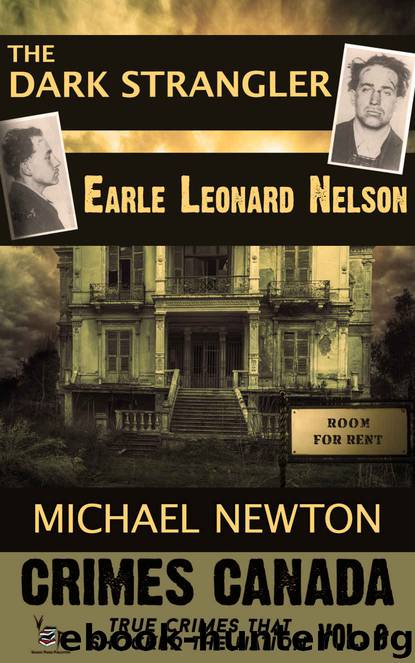The Dark Strangler: Serial Killer Earle Leonard Nelson (Crimes Canada: True Crimes That Shocked the Nation Book 9) by Newton Michael & Parker RJ & Vronsky Peter

Author:Newton,Michael & Parker,RJ & Vronsky,Peter [Newton,Michael & Parker,RJ & Vronsky,Peter]
Language: eng
Format: epub
Publisher: VP Publications an imprint of RJ Parker Publishing
Published: 2015-11-11T00:00:00+00:00
Emily Patterson
It came as no surprise to anyone, therefore, when jurors found Earle Nelson guilty as charged of Emily Patterson's murder on Friday, November 4, 1927. Justice Dysart heard that verdict and immediately sentenced Earle to die. Dysart granted Nelson sixty days for an appeal—denied—and penciled in his date with death for January 13, 1928, excluding legal holidays and weekends. After Manitoba's Court of Appeals rejected his final bid for life, Earle launched a last-ditch publicity campaign from death row, sitting for interviews with journalists and pleading innocence on all the charges lodged against him. He also met with Lola Cowan's mother, but maintained the fiction that she died at someone else's hand.
In Canada, hanging was the only mode of execution utilized from 1763, when France surrendered its northern holdings to Britain, until lawmakers banned capital punishment in July of 1976. During those 213 years, 1,481 defendants were condemned to hang and 719 actually mounted the gallows, including 697 men and 13 women. When carried out in an institutional setting—as opposed to lawless lynchings—authorities either construct or perpetually maintain a gallows platform mounted by stairs, with a trapdoor in its center to be opened by the executioner upon command. Before that happens, there are various procedures to observe: testing the subject's weight and measuring the rope, then fashioning the hangman's noose—a slip knot with six to eight coils, usually cinched behind the condemned inmate's left ear.
Ideally, when the trapdoor opens, the person being executed drops just far enough to have a broken neck produce unconsciousness before the noose completes its work of stifling the brain of oxygen. A rope too long may rip the subject's head off, while a length too short produces thrashing strangulation with the subject fully conscious until death, a bleak experience for both the prisoner and for spectators chosen by the court. The bottom line, however, is that hanging strangles its selected victims, whether they are conscious or oblivious—perhaps ironic, or a bit of karma in Earle Nelson's case.
Winnipeg's Vaughn Street Jail—the provincial capital's oldest public building, built in 1881—had seen its motley share of rogues before Earle Nelson came along. Vagrants and thieves, some as young as five years old, were caged with murderers and rapists in the latter 19th century, as were Big Bear and Poundmaker, two First Nations leaders of Canada's North-West Rebellion in 1885. Another famous inmate, John Queen, jailed during the Winnipeg General Strike of 1919, spent a year behind bars for "seditious conspiracy," was elected as a member of the legislative assembly while incarcerated, and later served as Winnipeg's mayor from 1935 to 1936, then again from 1937 to 1942.
There would be no happy ending for Earle Nelson, though. When jailers came for him on Friday, January 13, 1928, he offered no resistance, walking meekly to the execution chamber. There, he mounted the gallows steps unaided and faced the spectators below him. Before the noose was placed over his head and he was hooded to disguise the last contortions of his dying face, he told that group, "I am innocent.
Download
This site does not store any files on its server. We only index and link to content provided by other sites. Please contact the content providers to delete copyright contents if any and email us, we'll remove relevant links or contents immediately.
Mindhunter: Inside the FBI's Elite Serial Crime Unit by John E. Douglas & Mark Olshaker(8708)
Wiseguy by Nicholas Pileggi(5323)
Hitman by Howie Carr(4830)
Room 212 by Kate Stewart(4741)
Secrecy World by Jake Bernstein(4393)
Killers of the Flower Moon: The Osage Murders and the Birth of the FBI by David Grann(4192)
Breaking Free by Rachel Jeffs(4013)
Papillon (English) by Henri Charrière(3913)
Killers of the Flower Moon by David Grann(3753)
Say Nothing by Patrick Radden Keefe(3730)
American Kingpin by Nick Bilton(3510)
The Secret Barrister by The Secret Barrister(3425)
Molly's Game: From Hollywood's Elite to Wall Street's Billionaire Boys Club, My High-Stakes Adventure in the World of Underground Poker by Molly Bloom(3338)
Mysteries by Colin Wilson(3253)
In Cold Blood by Truman Capote(3140)
I'll Be Gone in the Dark by Michelle McNamara(2890)
Signature in the Cell: DNA and the Evidence for Intelligent Design by Stephen C. Meyer(2879)
Rogue Trader by Leeson Nick(2830)
Bunk by Kevin Young(2809)
